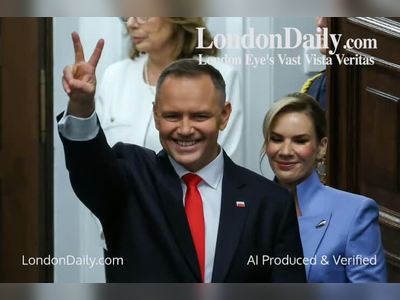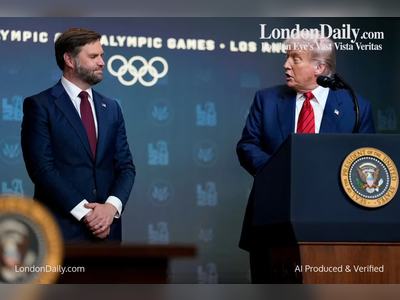U.S. Tariff Policy Triggers Market Volatility Amid Growing Global Trade Tensions
Equity selloff, inflation risks, and policy uncertainty follow new tariff announcements and partial pauses
New U.S. tariff measures have triggered sharp movements in global financial markets, adding to an environment of heightened policy uncertainty and trade tensions.
The S&P 500 index has declined by ten percent over two days, while U.S. high-yield credit spreads have widened to levels last seen during the 2020 pandemic market shock.
The selloff comes despite strong U.S. economic indicators, including a positive jobs report.
The U.S. administration has paused the majority of newly announced tariffs for ninety days, just hours after they were due to take effect.
The pause excludes China, which remains subject to increased tariffs, currently estimated at one hundred forty-five percent on certain goods.
The administration also retained a universal ten percent tariff on most imports.
The pause is being interpreted as an effort to manage financial market risks and encourage bilateral negotiations.
Analysts estimate that, even with the pause, the average effective U.S. tariff rate now stands at approximately twenty percent — a level not seen in a century.
China has responded with retaliatory tariffs of up to thirty-four percent and additional export controls.
Other countries are preparing similar responses, though timelines and negotiation outcomes remain uncertain.
Three primary types of tariffs have been identified.
First, sectoral tariffs target industries such as autos, steel, and aluminum, with potential future inclusion of lumber, semiconductors, pharmaceuticals, and copper.
Second, a universal tariff aims to raise revenue and support domestic production.
Third, country-specific tariffs affect approximately sixty nations with significant goods trade surpluses with the United States.
Economists anticipate that the tariffs will act as a drag on global growth while adding inflationary pressure.
In Europe, increased fiscal spending — such as Germany’s one trillion euro package for defense and infrastructure — may help mitigate the impact.
In the U.S., concerns persist that prolonged policy uncertainty could weigh on consumer confidence, corporate investment, and foreign demand for U.S. assets.
Federal Reserve Chair Jerome Powell has reaffirmed the importance of price stability, signaling that expectations of four to five interest rate cuts in 2025 may be excessive.
U.S. core inflation continues to exceed the Fed’s two percent target.
In response to near-term volatility, investment strategies have shifted.
Short-term U.S. Treasuries are gaining preference as a haven, while long-term Treasuries remain underweighted due to persistent fiscal deficits and elevated inflation.
Equities are seeing sector rotation, with opportunities emerging in U.S. technology firms and global financial institutions, particularly European banks affected by the selloff.
Gold is being favored as a portfolio diversifier amid uncertainty.
While short-term caution remains, some analysts have extended their tactical investment horizon from three to six-to-twelve months, citing potential market stabilization if trade policy clarity improves and economic fundamentals remain resilient.
The first quarter corporate earnings season is being closely watched for insights into how firms are adapting to the evolving tariff landscape.
The situation remains fluid, with further negotiation outcomes and policy decisions expected to influence both global markets and economic forecasts in the months ahead.
The S&P 500 index has declined by ten percent over two days, while U.S. high-yield credit spreads have widened to levels last seen during the 2020 pandemic market shock.
The selloff comes despite strong U.S. economic indicators, including a positive jobs report.
The U.S. administration has paused the majority of newly announced tariffs for ninety days, just hours after they were due to take effect.
The pause excludes China, which remains subject to increased tariffs, currently estimated at one hundred forty-five percent on certain goods.
The administration also retained a universal ten percent tariff on most imports.
The pause is being interpreted as an effort to manage financial market risks and encourage bilateral negotiations.
Analysts estimate that, even with the pause, the average effective U.S. tariff rate now stands at approximately twenty percent — a level not seen in a century.
China has responded with retaliatory tariffs of up to thirty-four percent and additional export controls.
Other countries are preparing similar responses, though timelines and negotiation outcomes remain uncertain.
Three primary types of tariffs have been identified.
First, sectoral tariffs target industries such as autos, steel, and aluminum, with potential future inclusion of lumber, semiconductors, pharmaceuticals, and copper.
Second, a universal tariff aims to raise revenue and support domestic production.
Third, country-specific tariffs affect approximately sixty nations with significant goods trade surpluses with the United States.
Economists anticipate that the tariffs will act as a drag on global growth while adding inflationary pressure.
In Europe, increased fiscal spending — such as Germany’s one trillion euro package for defense and infrastructure — may help mitigate the impact.
In the U.S., concerns persist that prolonged policy uncertainty could weigh on consumer confidence, corporate investment, and foreign demand for U.S. assets.
Federal Reserve Chair Jerome Powell has reaffirmed the importance of price stability, signaling that expectations of four to five interest rate cuts in 2025 may be excessive.
U.S. core inflation continues to exceed the Fed’s two percent target.
In response to near-term volatility, investment strategies have shifted.
Short-term U.S. Treasuries are gaining preference as a haven, while long-term Treasuries remain underweighted due to persistent fiscal deficits and elevated inflation.
Equities are seeing sector rotation, with opportunities emerging in U.S. technology firms and global financial institutions, particularly European banks affected by the selloff.
Gold is being favored as a portfolio diversifier amid uncertainty.
While short-term caution remains, some analysts have extended their tactical investment horizon from three to six-to-twelve months, citing potential market stabilization if trade policy clarity improves and economic fundamentals remain resilient.
The first quarter corporate earnings season is being closely watched for insights into how firms are adapting to the evolving tariff landscape.
The situation remains fluid, with further negotiation outcomes and policy decisions expected to influence both global markets and economic forecasts in the months ahead.









